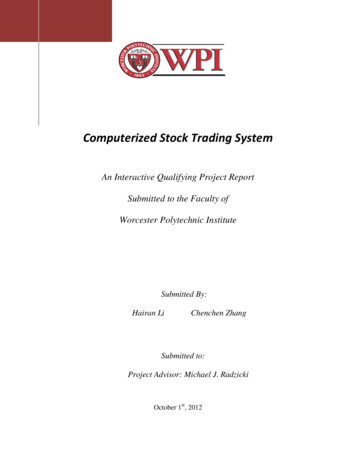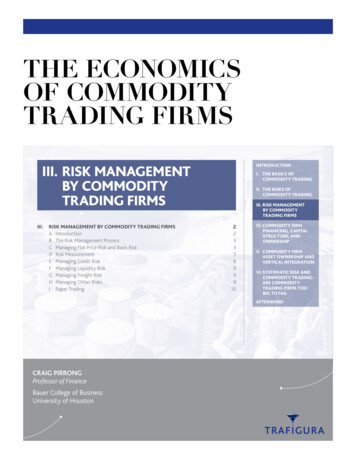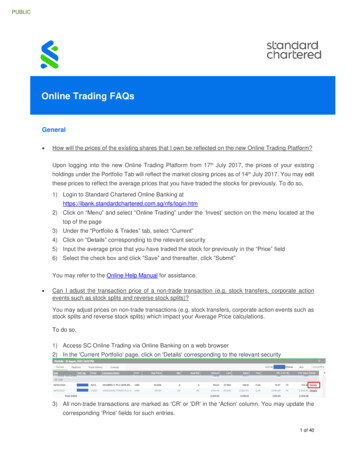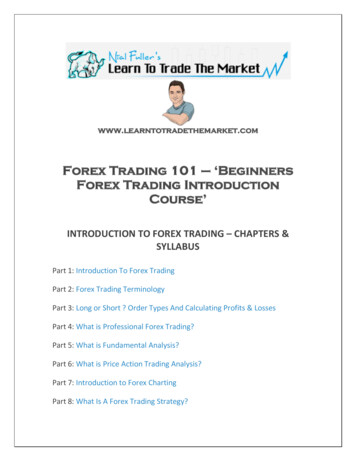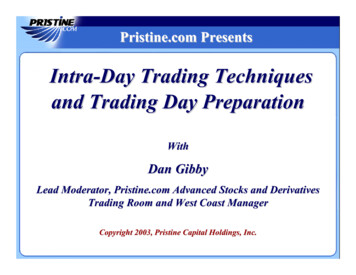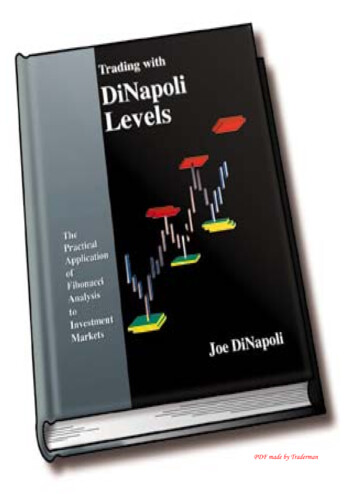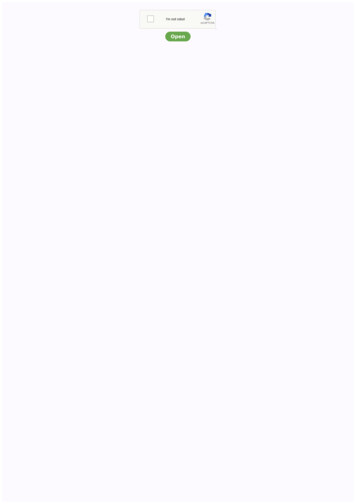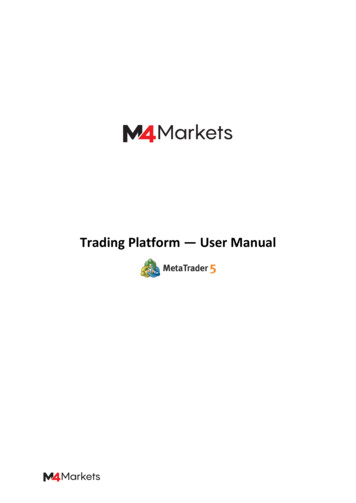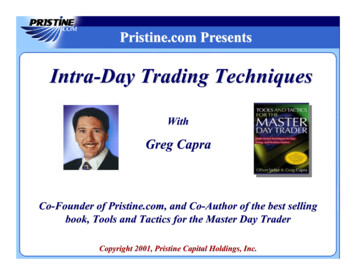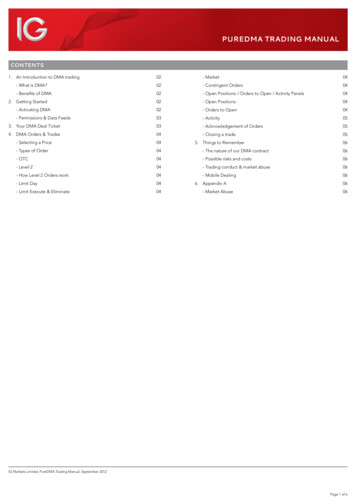
Transcription
PUREDMA TRADING MANUALContents1. An Introduction to DMA trading02- Market04- What is DMA?02- Contingent Orders04- Benefits of DMA02- Open Positions / Orders to Open / Activity Panels042. Getting Started02- Open Positions04- Activating DMA02- Orders to Open04- Permissions & Data Feeds03- Activity053. Your DMA Deal Ticket03- Acknowledgement of Orders054. DMA Orders & Trades04- Closing a trade05- Selecting a Price045. Things to Remember06- Types of Order04- The nature of our DMA contract06- OTC04- Possible risks and costs06- Level 204- Trading conduct & market abuse06- How Level 2 Orders work04- Mobile Dealing06- Limit Day04- Limit Execute & Eliminate 046. Appendix A- Market Abuse0606IG Markets Limited, PureDMA Trading Manual, September 2012Page 1 of 6
1. An Introduction to DMA tradingPlease note that, while we have tried to make this manual as useful as possible, nothing in it in any way affects our customer agreement which covers all transactions withus. If there is any inconsistency between this trading manual and our customer agreement, the terms of the customer agreement will prevail.What is DMA?Our DMA technology allows more experienced traders direct marketaccess (DMA).The option to enable DMA trading is activated when your account reaches acertain balance, but DMA functionality will note be removed should account laterfall below this balance.Benefits of DMAUsing DMA allows you to view market depth and trade directly into the order bookof equity exchanges worldwide. This is also known as ‘Level 2’ trading.There are a number of advantages to trading this way:TRADE INSIDE THE SPREADAs a DMA trader, you can set your own price and deal directly with other marketparticipants. This can help minimise the cost of the bid/offer spread on yourtrading, and can even work in your favour if you have an order to buy that is filled atthe ‘Bid Price’ or an order to sell that is filled at the ‘Offer Price’.GET FULL ACCESS TO PRICES IN SIZEGreater transparency allows you to consider market liquidity when placing a tradeand will very often ensure that your trades are executed at the price you choose.This will allow you to avoid having your orders rejected.ENTER AUCTIONSAs a Level 2 trader you can enter stock auctions taking place outside trading hours,when the best prices are sometimes available.COMPARE BUYING VS. SELLING INTERESTYou can see a queue of orders waiting to be filed at various prices for a particularstock. Knowing how many bids and offers are queued on each side of the orderbook may offer some insight into the possible future direction of the stock.HARNESS MULTI-VENUE TECHNOLOGYAs well as using traditional exchanges, PureDMA also sources prices from Europe’sthree leading Multilateral Trading Facilities (which act as alternatives to traditionalexchanges) and adds them to the order book in our trading platform. This lets youbenefit from additional market liquidity and better prices on direct market accessshare CFDs.2. Getting StartedActivating DMAWhen you have clicked to agree, the box will expand:There are two steps you must take in order to activate DMA trading onyour account.First, you need to activate DMA in your preferences.Once you have checked ‘Enable DMA’, you will see the DMA agreement pop-up.You must accept this agreement to continue.If you want to see a summary of each order before it is sent, tick the‘Show Summaries’ box.To limit the extent of any damage done by ‘typo’ errors when entering figures in adeal ticket, you must set a maximum allowed value for individual transactions here.IG Markets Limited, PureDMA Trading Manual, September 2012Page 2 of 6
Once you have done this, simply scroll down to save your preferences and move on to the second part of the activation process.Live price feeds are used to view a market’s depth and make DMA trades.We offer free live prices on more than 1450 top UK and European shares as standard.A large number of other Level 2 (DMA) data feeds are also available and can be activated from the ‘My Account’ panel in our trading platform.3. Your DMA Deal Ticket01. Current share price02. Best available price03. Volume of shares at best bid price04. Market depth information for bid orders (volume/price)05. Switch trade direction06. Size and level of order07. Stop / limit orders08. Overall value of trade (i.e. 2000 shares at 2 4000consideration)09. Amount of margin required to place the trade10. Maximum consideration (can be set in SMA preferences)11. Type of order12. Market depth information for ask orders (price/volume)13. Volume of shares at best price offer14. Best available offer price15. Switch between DMA and OTC deal tickets16. The day’s high and low traded on the exchangeIG Markets Limited, PureDMA Trading Manual, September 2012Page 3 of 6
4. DMA Orders and TradesSelecting a PriceTo select a price, simply open a ‘Deal Ticket’ and click on a price at which you want to trade. Alternatively, you can enter the price into the ‘Order Level’ box in thedeal ticket. If you click on a ‘bid’ price, the trade will default to a selling position, and if you click on an ‘offer’ price, the default will be to buy. Change trade direction byclicking the down arrow.Types of OrderOTCEven when ‘Level 2’ trading is activated, it is possible to place an Over theCounter (OTC) order by using the DMA/OTC tab on deal tickets. It is also possibleto open a position DMA but close it OTC and vice versa.Level 2DMA orders are quite different from OTC orders, and it is therefore important tounderstand exactly what varying types of Order mean before placing them.MARKETA Market Order can be placed at any time and sweeps the opposite side of theorder book until the entire order is filled, regardless of price. For example, if youopen a Market Order to buy 10,000 shares, you would get 4756 at 1364, 5000 at1365 and the final 244 at 1366.It is also possible to place Market Orders during the auction periods of equityexchanges. Auctions normally take place before markets open or at the end of thetrading day. For example, on the London Stock Exchange, auctions take place dailybetween 07.50-08.00 and 16.30-1635 GMT. However, sometimes a stock will go intoauction during normal trading; when this happens, a red bar will highlight the bestbid and offer prices in the stock’s Deal Ticket.There are three listed ‘Level 2’ order types to choose from: Limit – Day Limit – Execute & Eliminate MarketContingent OrdersStop and limit orders work in the same way as they do with OTC trades in that theyare filled by us rather than in the market. A stop order is an instruction to deal ata less favourable level than the current price, and a limit order is an instruction todeal at a more favourable level. NB: To attach a limit order to a trade, the trademust be active; it is not possible to attach limit to an inactive, partially filled trade.Open Positions / Orders to Open / ActivityPanelsOpen PositionsTrades that appear in the Open Positions panel have been filled or partially filled:[The DMA deal ticket shows no distinction between different types of Market Orderbecause these orders are modified automatically depending on the circumstancesof the trade].How Level 2 Orders WorkPlease note that not all exchanges will process order types exactly as they areoutlined below. Contact your local dealing desk for more information.The following explanations refer to this Order Book, from Rio Tinto: illed trades are displayed alongside a green icon to indicate that theyFare active. artially filled trades are displayed alongside a grey icon to indicate that theyPare inactive.To activate a partially filled trade, either fill or cancel the unfilled remainder.Orders to OpenOrders which appears in the Orders to Open panel are still working in the market,waiting to be filled. For example, the remainder of a partially filled Open Position,or a standalone Working Order, would appear in the Orders to Open panel.For example:Imagine you have placed this order:Limit DayThis is an Order with a specified size and price which executes against eligibleOrders, with any remaining unexecuted portion added to your Orders to Open.This remainder will stay active until the end of the day’s trading, when it will becancelled. For example, a Limit Day order to buy 5000 Rio Tinto shares at 1364would execute an Order for 4756 shares. The remaining 244 shares would beadded to your Orders to Open, until that many shares become available at a priceof 1364. If the remaining order of 244 shares is not filled before the end of the day,the Order to Open will be cancelled. Once this remainder is cancelled, the OpenPosition will become active.Limit Execute and EliminateThis will execute as much of the trade as possible at the level you specify beforecancelling any remaining balance. For example, an Order to sell 1000 shares at1363 would sell 736 shares at that level and the remaining balance of 264 shareswould be cancelled immediately. At the moment the remainder is cancelled, theOpen Position of 736 shares becomes active.Please note that Execute and Eliminate Orders cannot be placed during auctionperiods (see below).(A limit-Day Order to buy 5000 British Sky Broadcasting plc shares atthe best price of 171.50)IG Markets Limited, PureDMA Trading Manual, September 2012Page 4 of 6
There are 4147 shares available to buy at 171.50. Looking at the market depth, the next best price is 171.90 (where there are 12,290 shares for sale).Because this is a Limit Day Order, a position is opened buying the available 4147 shares at 171.50 and the remaining 853 shares becomes an Order to Open, waiting to befilled at a price of 171.50.By ensuring your remaining order to buy 853 shares is filled at a price of 171.50, rather than 171.90 – the best offer price available after you have bought the initial 4147shares – you are trading within the bid/offer spread.The two orders would be displayed like this:To activate the Open position (buying 4147 shares at 171.50) you would have to fill or delete the Order to Open for 853 shares at 171.50. As this is a Limit Day Order,the Order to Open will only remain active until the end of the day.ACTIVITYThis panel displays all your recent trades, including the date and time of the trade, the equity traded, whether the trade was a complete order or a partial fill and whetherit was made OTC or DMA.Acknowledgement of OrdersWhen you place a DMA order, you will receive a pop-up acknowledgement (with an orange icon) to confirm the market you are trading, the order level and size, andthe trade’s unique reference code. Remember, this is an acknowledgement that you have placed an order and that it has been sent; it is not a confirmation that theorder has been filled. To see an order’s status, check the Open Positions and Orders to Open panels. The Activity panel will also display a history of recent tradingactions you have taken.Closing a TradeIt is possible to open an L2 position using the DMA section of the Deal Ticket, but close the position using the OTC section, and vice versa.If you use a Deal Ticket to close a specific open position, you will be able to do so either by sending a Limit Execute and Eliminate Order or Limit Day order.With an Execute and Eliminate order, as much of the position as possible will be closed at the level you specify, and the remainder will stay open. The extent to which theorder to close a position can be filled depends on the availability of buyers at your selling price (or sellers at your buying price). To close any remaining part of the position,you would have to send a separate order.If you use a Limit Day order to close a position, as much of your trade as possible will be executed at your chosen price. Any unexecuted part of the trade will remain activeuntil the end of the day’s trading when any unfilled portion of the trade will be cancelled.IG Markets Limited, PureDMA Trading Manual, September 2012Page 5 of 6
5. Things to RememberThe nature of our DMA contractTrading conduct & market abuseIt is important to note that while you are trading based on underlying market pricesand depth, what you actually receive on placing a trade is a CFD from us. It workslike this:Since, as a Level 2 trader, you are effectively participating directly in the market, it isyour responsibility to acquaint yourself with all the relevant rules and legislation forthe exchange on which you are trading. MA displays the best bid and offer price available for a particular market,Das well as up to four further – ‘market depth’ – prices on either side of theorder book; ou then place an order using a DMA Deal Ticket and we instantaneouslyYconduct a margin check to ensure you have sufficient funds on account tocover margin on your proposed trade; I f the margin check is satisfied, we will place an order in our name in the marketand, simultaneous to this, we will create a parallel CFD between you and us.In the UK, for example, you should be aware of the requirements of theTakeover Panel, and your obligation to report positions in certain circumstances(thetakeoverpanel.org.uk provides more information). You should be awarethat notwithstanding you do not gain ownership rights to the actual underlyingasset (but rather gain a CFD from us) there will be some instances where you arenonetheless required to disclose your interest to the UK Takeover Panel (or similarbody in your jurisdiction). You will also be bound by the rules of the exchangeon which you are trading. For example, if you are trading on the London StockExchange you should be aware that we are bound by the LSE rules and thatyou must avoid taking any action that might put us in breach of those rules. TheGeneral Conduct section of the LSE rules is likely to be the most relevant and canbe found at rading/rulesreg/ruleslse/So while you are trading at market prices, you do not gain any ownership rightsover the shares or futures which form the subject of your CFD.Possible risks and costsBecause we take our own position in the underlying market in order to provide youwith a parallel contract, it is important to remember that once an order has beenexecuted we are unable to change or reverse your position. If you have incorrectlyor erroneously submitted an order you are bound by the size and price at which theorder has been executed.Mobile DealingOur iPhone and iPad apps support DMA trades for clients with PureDMA activatedin their account settings. DMA trading is not yet available on our platform on othermobile devices.If you short-sell a stock and the underlying share becomes unborrowable,meaning that we are unable to hedge against possible losses, your order willbe closed at the market level. A share may either be unborrowable from theoutset or our brokers or agents may recall from us a stock that we have alreadyborrowed against.Before activating DMA, you should fully understand the costs involved. Dependingon the exchange on which you wish to trade, you may be liable to pay some datausage fees (see Permissions and Data Feeds, p.3). You should also be aware that,under the terms of our customer agreement, you agree to indemnify us for anytransaction costs, such as stock borrowing fees, which we incur as a result of yourtransaction. Contact us for more information on these costs plus commission andfunding charges.6. Appendix AMarket AbuseUnder the EU Market Abuse Directive there are seven types of behaviour whichmay constitute market abuse. These are set out in summary below.Abuse 1: Insider dealingThis is where an insider i.e. a person in possession of unpublished price sensitiveinformation deals or attempts to deal in a qualifying investment on the basis ofthat information.ABUSE 2: IMPROPER DISCLOSUREThis is when an insider discloses inside information to another person otherwisethan in the proper course of the exercise of this employment, profession or duties.ABUSE 3: MISUSE OF INFORMATIONThis is where the behaviour does not amount to insider dealing or improperdisclosure but:a) is based on information not generally available to those using the marketbut which, if available to a regular user of the market, would be. Or would belikely to be, regarded by him as relevant when deciding the terms on whichtransactions in qualifying investments should be effects; andb) is likely to be regarded by a regular user of the market as a failure on the partof the person concerned to observe the standard of behaviour reasonablyexpected of a person in his position in relation to the market.ABUSE 4: MANIPULATING TRANSACTIONSThis consists of effecting transactions or orders to trade (otherwise than forlegitimate reasons) which:a) give, or are likely to give a false or misleading impression as to the supply of, ordemand for, or as to the price of a qualifying instrument; orb) secure the price of an investment at an abnormal or artificial level.ABUSE 5: MANIPULATING DEVICESThe fifth type of behaviour consists of effecting transactions or orders to tradewhich employ fictitious devices or any other form of deception.ABUSE 6: DISSEMINATIONThe sixth type of behaviour consists of the dissemination of information whichgives, or is likely to give, a false or misleading impression as to an investmentby a person who knew or could reasonably be expected to have known that theinformation was false or misleading.ABUSE 7: MISLEADING BEHAVIOUR AND DISTORTIONThe seventh type of behaviour (where abuse does not amount to any of thebehaviours in respect of manipulation or dissemination described above) is where it:a) is likely to give a regular user of the market a false or misleading impression asto the supply of, demand for or price or value of an investment; orb) would be, or would likely to be, regarded by a regular user of the marketas behaviour that would distort or be likely to distort the market in suchan investment.IG Markets Limited, PureDMA Trading Manual, September 2012Page 6 of 6
IG Markets Limited, PureDMA Trading Manual, September 2012 Page 1 of 6 CoNTENTs 1.oduction to DMA trading An Intr 02 - What is DMA? 02 - Benefits of DMA 02 2. Getting Started 02 - Activating DMA 02 - Permissions & Data Feeds 03 3. Your DMA Deal Ticket 03 4. DMA Orders & Trades 04 - Selecting a Price 04 - Types of Order 04 - OTC 04 - Level 2 04


